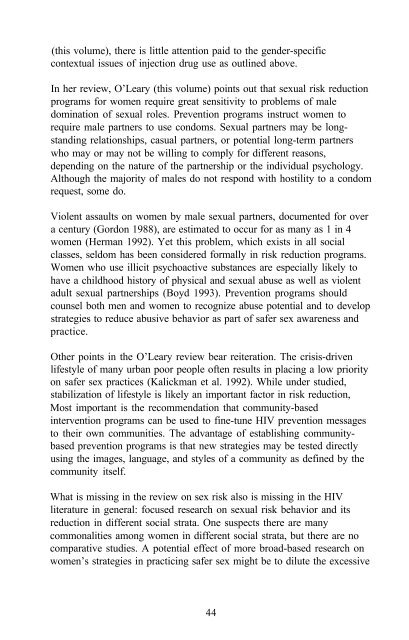The Context of HIV Risk Among Drug Users and Their Sexual Partners
The Context of HIV Risk Among Drug Users and Their Sexual Partners
The Context of HIV Risk Among Drug Users and Their Sexual Partners
You also want an ePaper? Increase the reach of your titles
YUMPU automatically turns print PDFs into web optimized ePapers that Google loves.
(this volume), there is little attention paid to the gender-specific<br />
contextual issues <strong>of</strong> injection drug use as outlined above.<br />
In her review, O’Leary (this volume) points out that sexual risk reduction<br />
programs for women require great sensitivity to problems <strong>of</strong> male<br />
domination <strong>of</strong> sexual roles. Prevention programs instruct women to<br />
require male partners to use condoms. <strong>Sexual</strong> partners may be longst<strong>and</strong>ing<br />
relationships, casual partners, or potential long-term partners<br />
who may or may not be willing to comply for different reasons,<br />
depending on the nature <strong>of</strong> the partnership or the individual psychology.<br />
Although the majority <strong>of</strong> males do not respond with hostility to a condom<br />
request, some do.<br />
Violent assaults on women by male sexual partners, documented for over<br />
a century (Gordon 1988), are estimated to occur for as many as 1 in 4<br />
women (Herman 1992). Yet this problem, which exists in all social<br />
classes, seldom has been considered formally in risk reduction programs.<br />
Women who use illicit psychoactive substances are especially likely to<br />
have a childhood history <strong>of</strong> physical <strong>and</strong> sexual abuse as well as violent<br />
adult sexual partnerships (Boyd 1993). Prevention programs should<br />
counsel both men <strong>and</strong> women to recognize abuse potential <strong>and</strong> to develop<br />
strategies to reduce abusive behavior as part <strong>of</strong> safer sex awareness <strong>and</strong><br />
practice.<br />
Other points in the O’Leary review bear reiteration. <strong>The</strong> crisis-driven<br />
lifestyle <strong>of</strong> many urban poor people <strong>of</strong>ten results in placing a low priority<br />
on safer sex practices (Kalickman et al. 1992). While under studied,<br />
stabilization <strong>of</strong> lifestyle is likely an important factor in risk reduction,<br />
Most important is the recommendation that community-based<br />
intervention programs can be used to fine-tune <strong>HIV</strong> prevention messages<br />
to their own communities. <strong>The</strong> advantage <strong>of</strong> establishing communitybased<br />
prevention programs is that new strategies may be tested directly<br />
using the images, language, <strong>and</strong> styles <strong>of</strong> a community as defined by the<br />
community itself.<br />
What is missing in the review on sex risk also is missing in the <strong>HIV</strong><br />
literature in general: focused research on sexual risk behavior <strong>and</strong> its<br />
reduction in different social strata. One suspects there are many<br />
commonalities among women in different social strata, but there are no<br />
comparative studies. A potential effect <strong>of</strong> more broad-based research on<br />
women’s strategies in practicing safer sex might be to dilute the excessive<br />
44
















